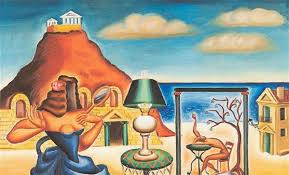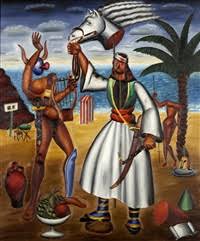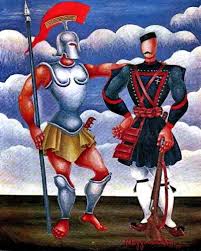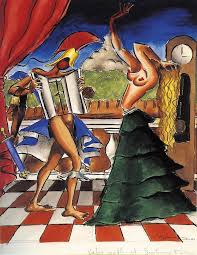Surrealism was an artistic and literary movement which originated in the late 1910s and early ‘20s which maintained that the superior qualities of the irrational, unconscious mind had to be liberated from the oppressive boundaries of reason and individualism that the Enlightenment imposed on all facets of artistic expression up to that point in time.
For many of us the most well-known artists of the Surrealist movement are Salvador Dali or – to those who might have a more intimate interest in the movement – Max Ernst and Marcel Duchamp might also ring a bell.
It is not often however, that light is shed to the life and works of Greek Surrealists. These artists managed to incorporate the depth of Greek mythology and history into the Surrealist movement, creating a body of work which was instantly recognizable due to its unique themes and aesthetics.
One such artist and a prominent representative of Greek surrealism, was Nikos Engonopoulos.
Engonopoulos was born in Athens in 1907, the second son of Panaghiotis and Errietti (Henrietta).
In 1914 the family travelled to Constantinople and due to the outbreak of the First World War were forced to settle there. In 1923, Engonopoulos enrolled in a lycée (high school) in Paris, where he studied for four years.
Upon his return to Greece, he completed his compulsory military duty and went on to work as a translator in a bank and as a secretary at the University of Athens.
In 1930 he worked as a designer in the Urban Planning Department of the Greek Ministry of Public Works and in 1932 he joined the Athens School of Fine Arts, where he studied under the supervision of Konstantinos Parthenis. Simultaneously, he attended the art studio of Photis Kontoglou and in the mid ‘30s he met the poet Andreas Embirikos and the painters Yannis Tsarouchis, Giorgio de Chirico and Yannis Moralis.
He first exhibited work in the 1938 the exhibition Art of the Modern Greek Tradition, organised by the Greek Popular Art Association.
This was followed by a series of artistic and literary successes, eventually earning him a place as one of the most important members of the ‘Generation of the ’30s’; group of Greek writers, poets, artists, intellectuals, critics, and scholars who introduced modernism in Greek art and literature.
In late 1940, Mussolini marched on Greece, followed shortly thereafter by the Nazis. Like other Greek intellectuals considered “troublemakers” by General Metaxas, Engonopoulos was drafted and sent to the front. Upon his return he was asked by friends to compose some poems of the Greek resistance – a request which led him to writing his poem Bolivar (1944). The poem created a stir amongst the intelligentsia causing people to take his writings and subsequently his paintings more seriously.
In 1958 he was awarded the First Prize for Poetry by the Ministry of National Education for his collection, In the Flourishing Greek Tongue and in 1966, for his work as a painter, he was awarded the Order of the Gold Cross of George I. In 1971 he participated in the exhibition Modern Greek Art on the 1821 War of Independence.
Painting – Sculpture – Engraving at the Greek Chamber of Art and was awarded the Cross of the Commander of the Phoenix.
Engonopoulos’ Surrealist works, both written and painted, explored a world of bravery, sacrifice and heroic achievement deeply embedded in the national psyche while deflty combining the modern world with the glorious past of ancient and Byzantine Greek history. As noted by the art historian N. Loizidi, “Engonopoulos gave us one version of surrealism, universal but at the same time deeply rooted in Greekness.” Engonopoulos died of a heart attack on 31 October 1985. He is buried in the First Cemetery of Athens.


















